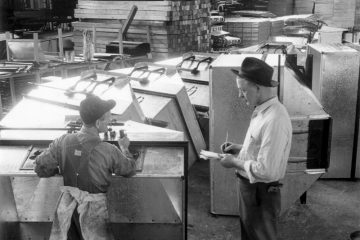When I joined the SJSU MLIS program, management–or even the notion of being in a business–was not in my mindset. Libraries seemed to me to be something else, unique and special and somehow outside of the “business world.” Well, I only had to be in the program for one semester (and take one class on management with Dr. Dee) to realize that information management IS a business, and as such we have to learn how to manage the business particularly in the special library world where often the library is part of a business and not a free-standing library. We have to face the fact that without profit, or at the least value, the library will be closed.
When I saw the MARA program “Using Lean Methods to Improve RIM Practices,” even though I didn’t know what either “Lean” or “RIM” was, I decided to dive in and see what I could learn from the management perspective I have come to realize is so fundamental to librarianship. As I listened to the program, it occurred to me that these processes can be implemented in our education as well. What follows is my beginner’s summary of some pretty complex (but interesting and useful) processes that can be applied to almost any special library. I hope you will bear with me as I try to make sense of them.
The presenter, Charlene Cunniffe, works in a special library as the Associate Director of Sanofi Information and Records Management. Sanofi is a French International Pharmaceutical and Healthcare company. Essentially, Cunniffe explained, Lean is the process of creating more value for customers with fewer resources. It emphasizes cost avoidance, cost reduction, and revenue growth while also maintaining customer and employee satisfaction and keeping up with any compliance issues.
When she first defined Lean, my immediate thought was, “Is that just a fancy word for firing people?” Cunniffe dispelled that notion, explaining that while too many employees can be a problem, the focus is really on process improvement. She actually never defined RIM, so I had to look that one up. Those of you in archives probably could have given me a quick explanation, but for those who might be as ignorant as I was, RIM is just a fancy acronym for Records and Information Management.
Cunniffe’s focus was on how to add value to information management through a process of making information and records management more profitable, more efficient, and faster. Cunniffe helped me think about different ways we can add value as information managers. Understanding these principles can also be helpful when we are applying for jobs. In a library, our “customers” are the users. We have to figure out how we can increase value for our users.
Cunniffe focused on 8 “waste” areas, but I’ll just touch on three that seem most relevant to the library:
- waiting (wasted time for both the user and the information manager);
- inventory (not having what the customer needs);
- overproduction (doing more than the user needs).
Cunniffe explained that within our information organization we want to identify problem areas within each category of waste, inventory and overproduction, and then go through a systematic process to improve or remove those areas, processes, and productions that result in inefficiency or do not add value to the customer. “Lean” is a five step process:
- First, define the problem and the hoped for changes, then write up a “charter” for all involved so that everyone is on the same page.
- Second, we want to measure the problem: Where is the waste in the current process, for example.
- Third, drill down to the root of the problem: Here the emphasis is on asking why do we do that, and why do we do that, and why do we do that until you’ve reached the root cause.
- Fourth, brainstorm possible solutions that might improve the problem and focus on those solutions with the highest benefit and the least effort.
- Fifth, and finally, we want to implement and monitor the new process, including who is in charge of what, how will we know when we are successful, and a timeline with 30-day, 60-day, and 90-day meetings (or however long we think it will take to reach success).
Many of us might not yet have a job where we can apply these principles, but they can also be useful in our education. How do we create more value with fewer costs through our education process? Cost doesn’t only have to mean money–where do we “spend” too much energy working or worrying, for example? Here is what the five step process might look like for my own education:
- Where is the waste in my process? Here we can apply this to overproduction of a sort as well. Where am I wasting time doing more than is necessary to get the most value from our program? For example, I have a tendency to go off on tangents and read just about everything that could possibly relate to a topic introduced in the classroom.
- How can I identify the causes of this waste? And measure them? The most waste needs the most attention. My tangential reading creates literally hours of “wasted” time that is not adding value to my program.
- What goals can I establish to help eliminate the waste? Perhaps I can set a goal of only spending 20 minutes on a tangential topic.
- What steps would it take to reach those goals? First, I might have to identify just exactly which topics lead to tangents for me and then slowly work on one at a time.
- And how would I measure success? If I could reduce my five-hour-a-week habit of following tangents to just one hour a week, I could declare success.
Writing this down in a “charter” can help us to stay focused on the issue and to take it seriously. Cunniffe provided plenty of detail for this process, but this is my understanding in a nutshell.
If you are interested in learning more about this process, you might check out these Web sites:
- RIM (Records and Information Management Programs) at content.arma.org
- Principles of Lean at lean.org
And, of course, you may want to check out the talk yourself. Cunniffe included a lot of very informative slides in her presentation that are worth taking a look at.


